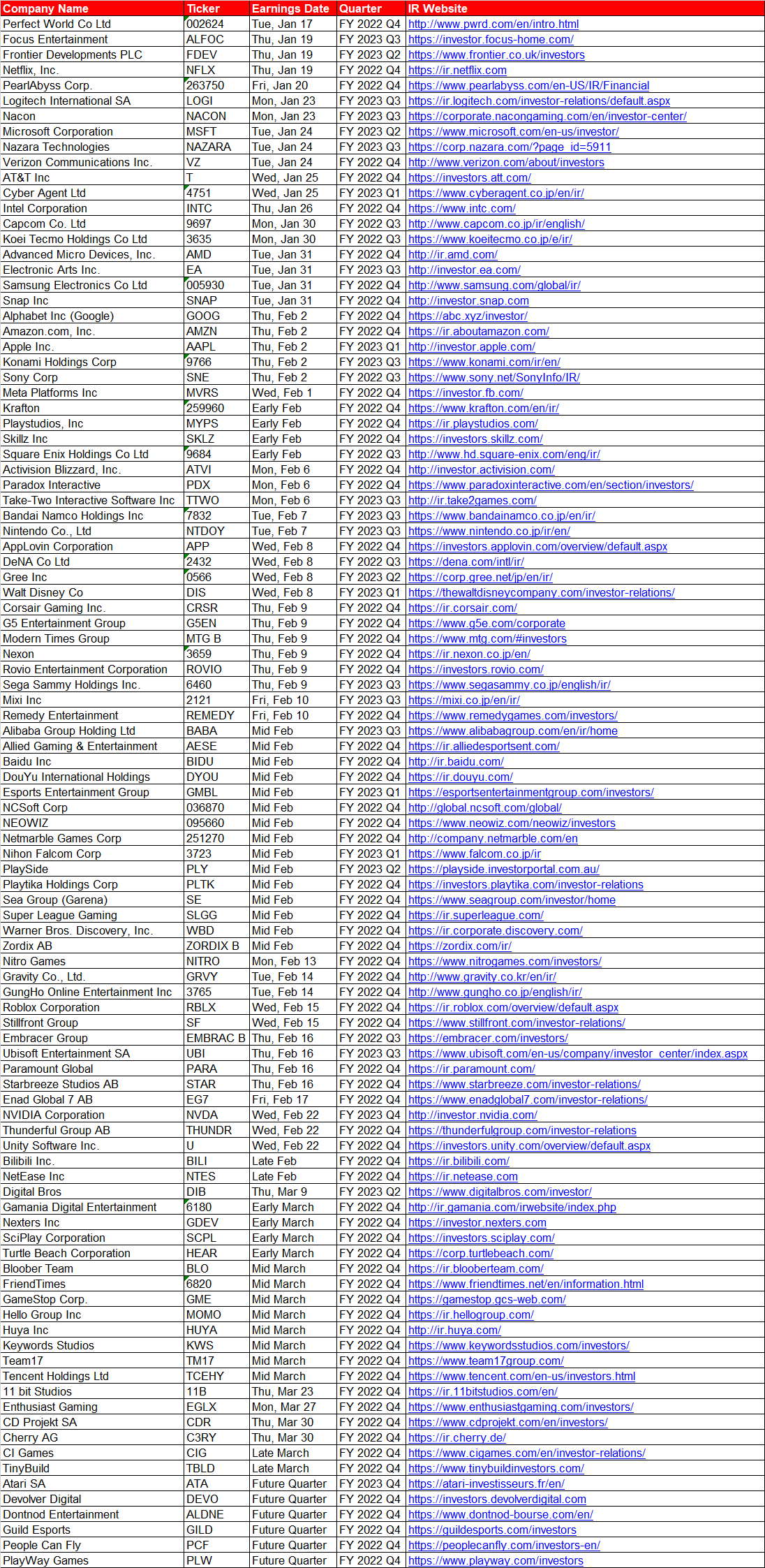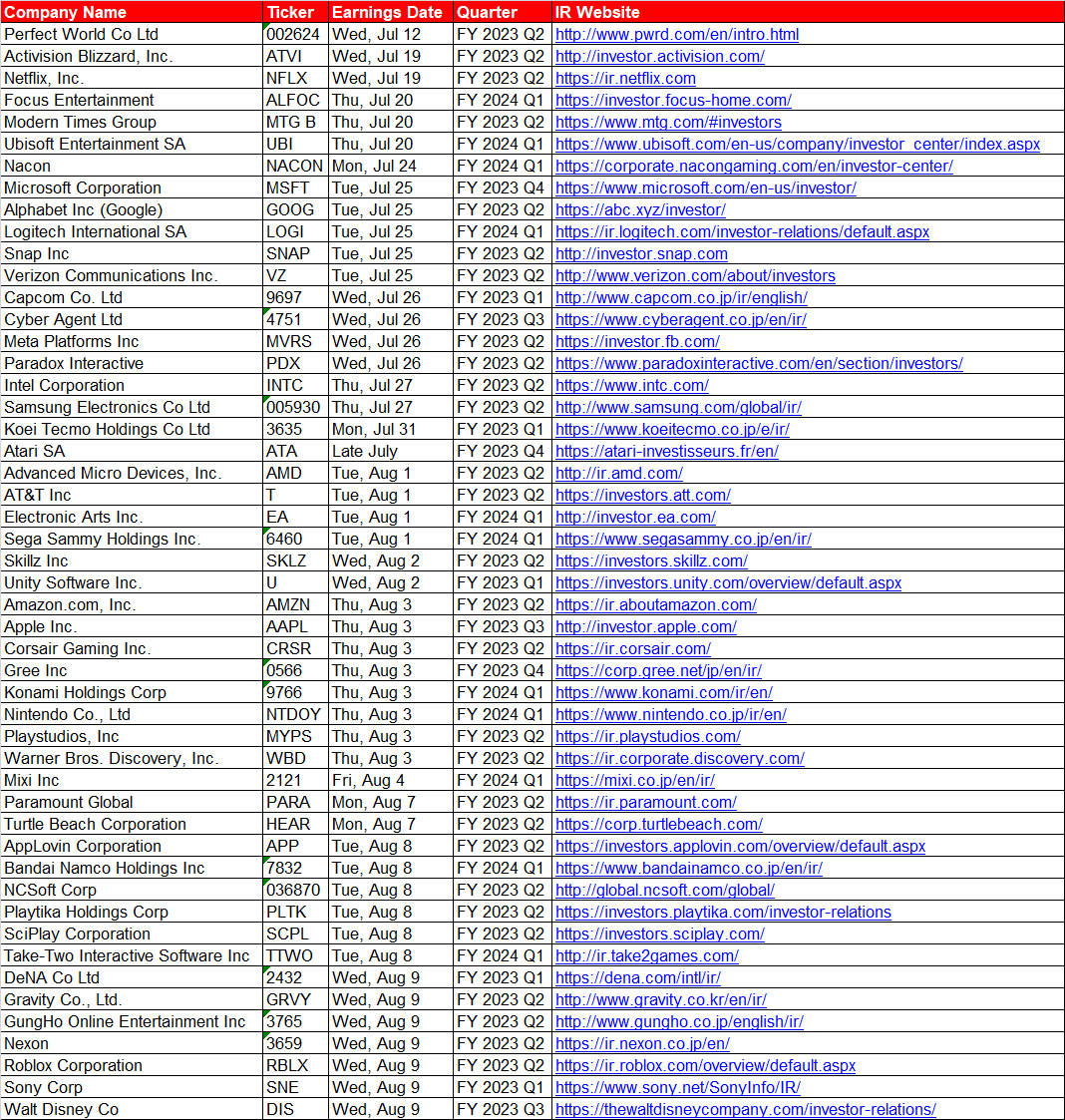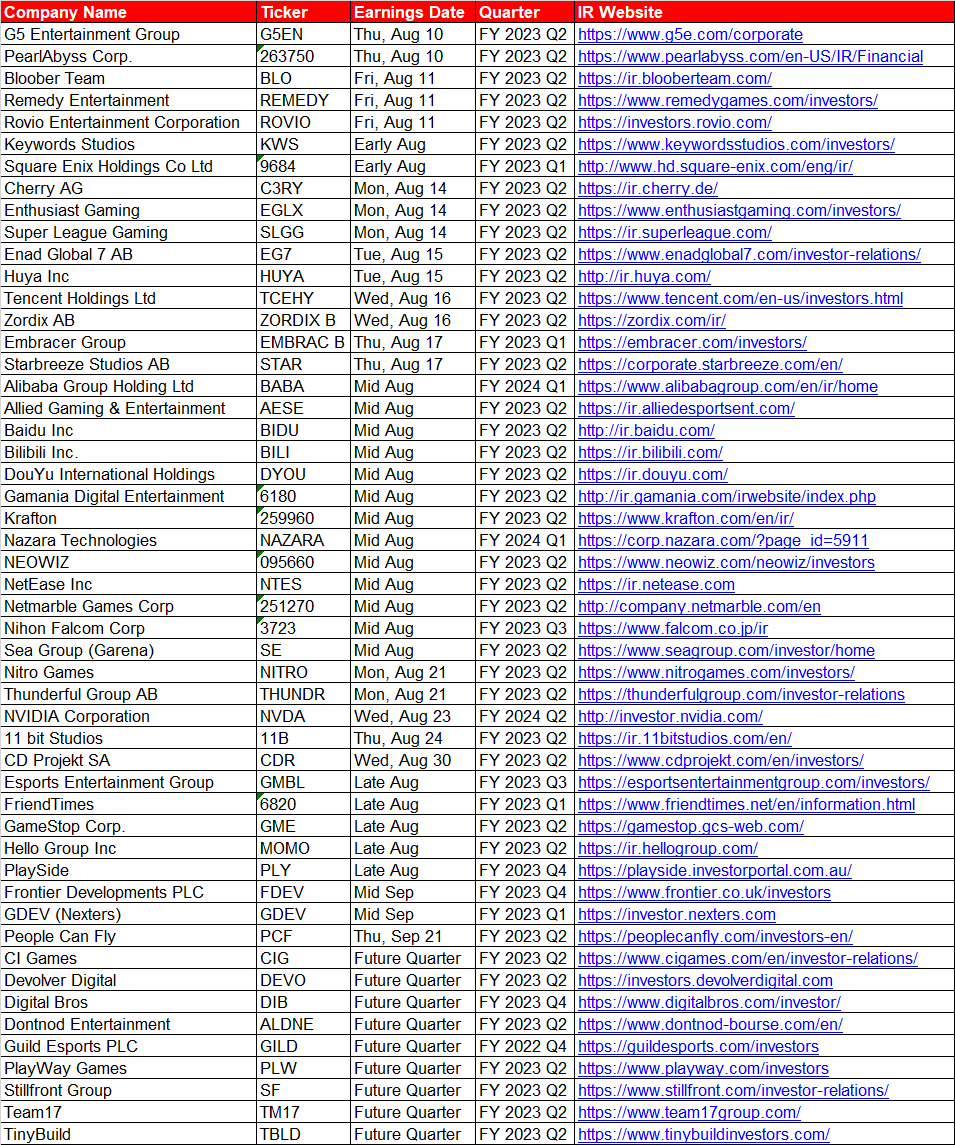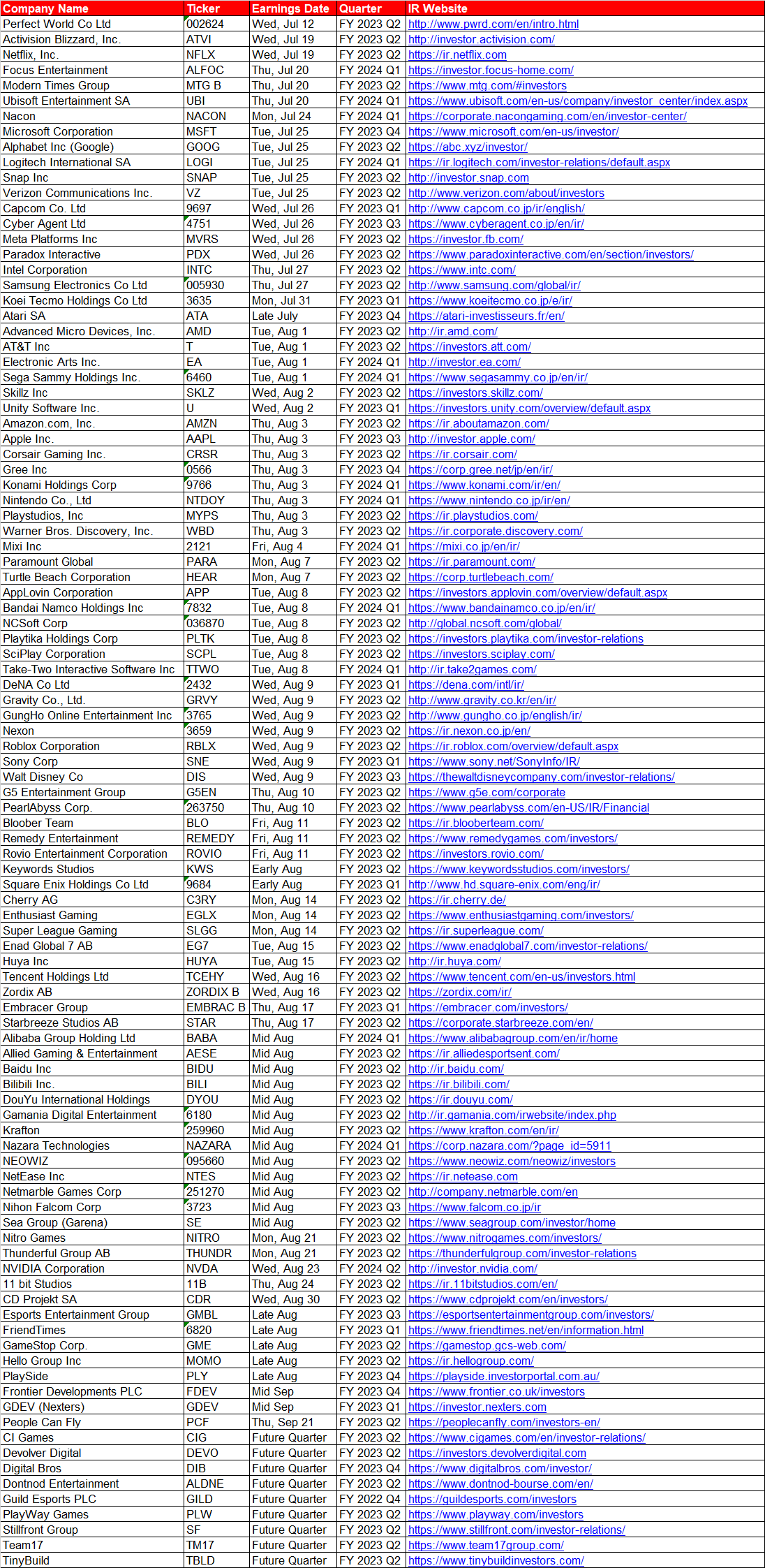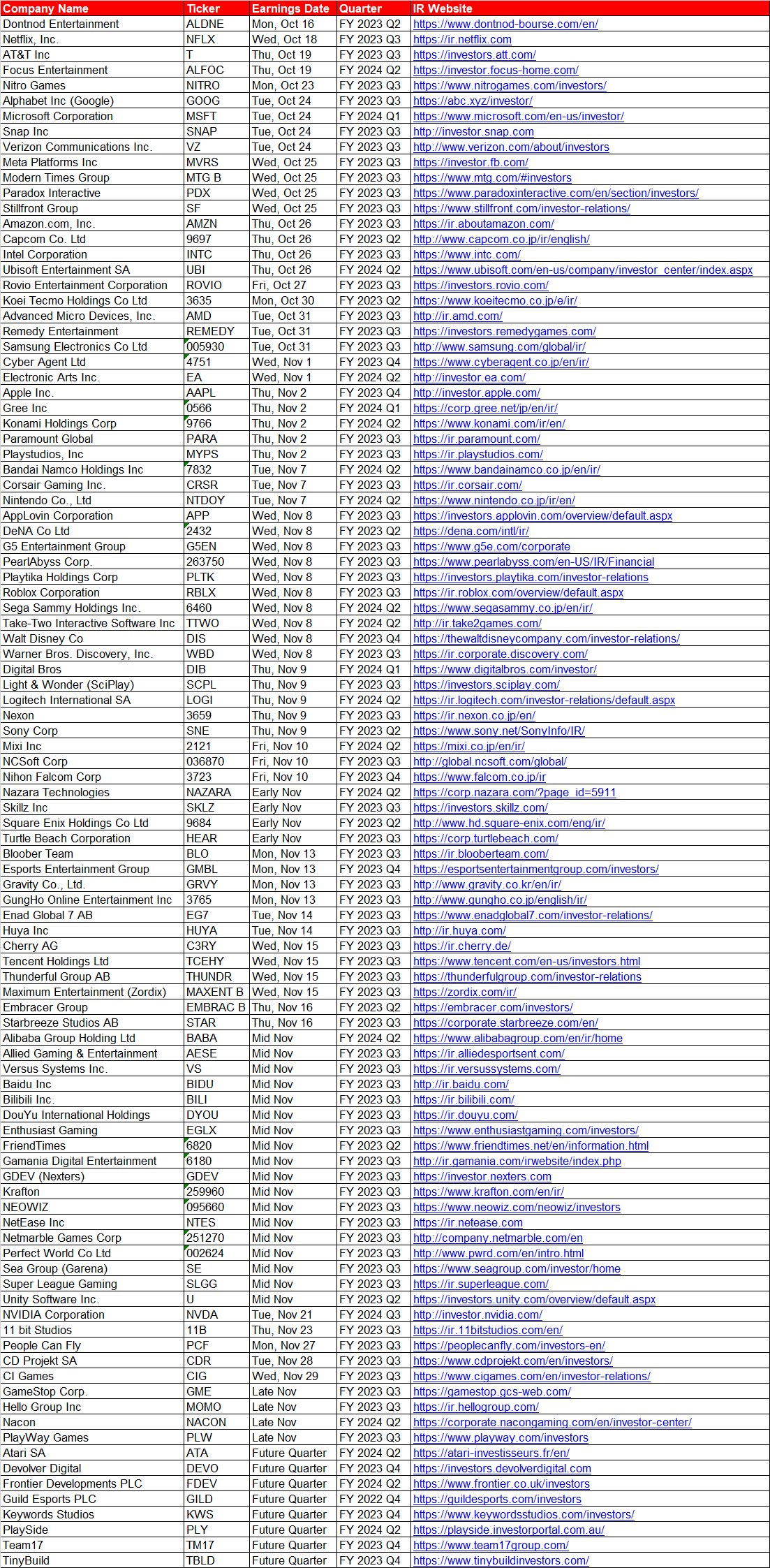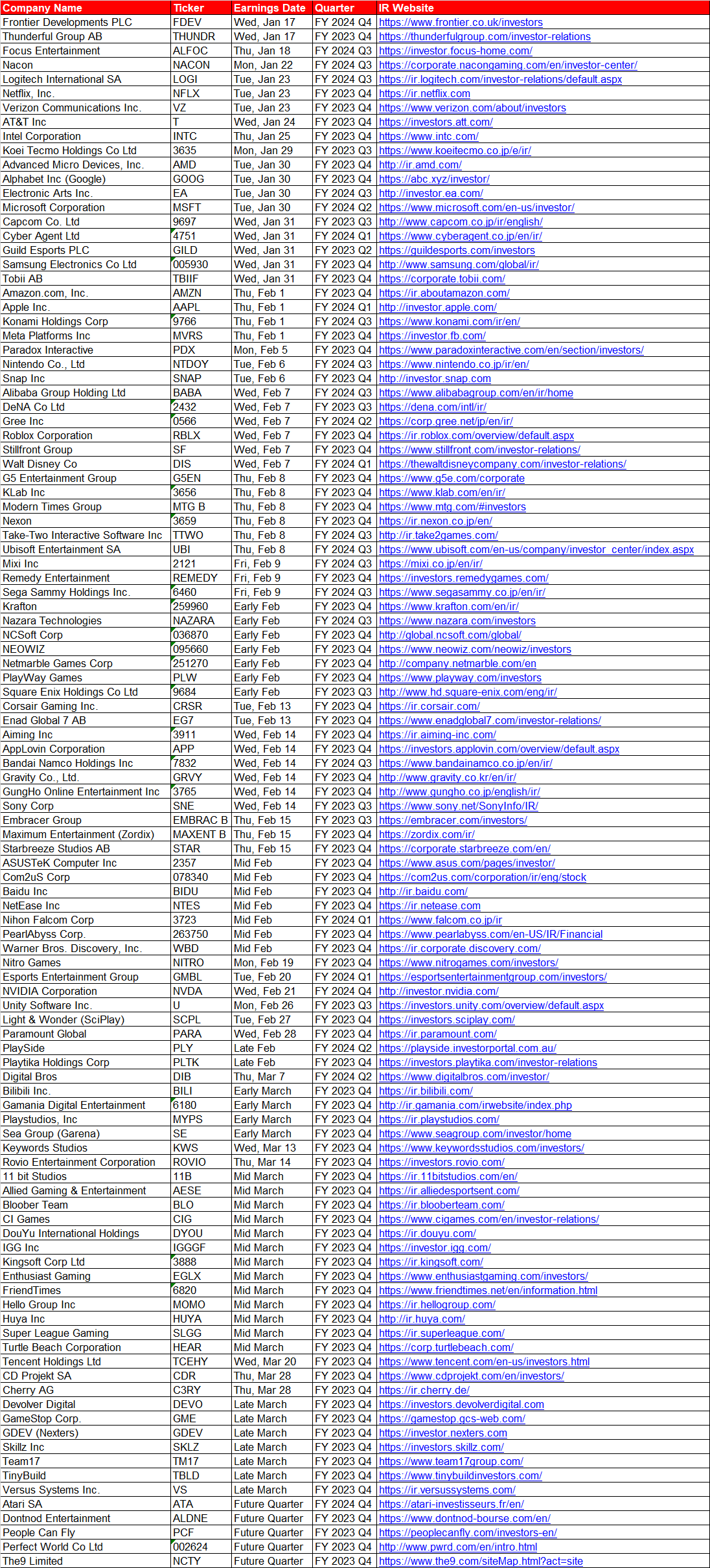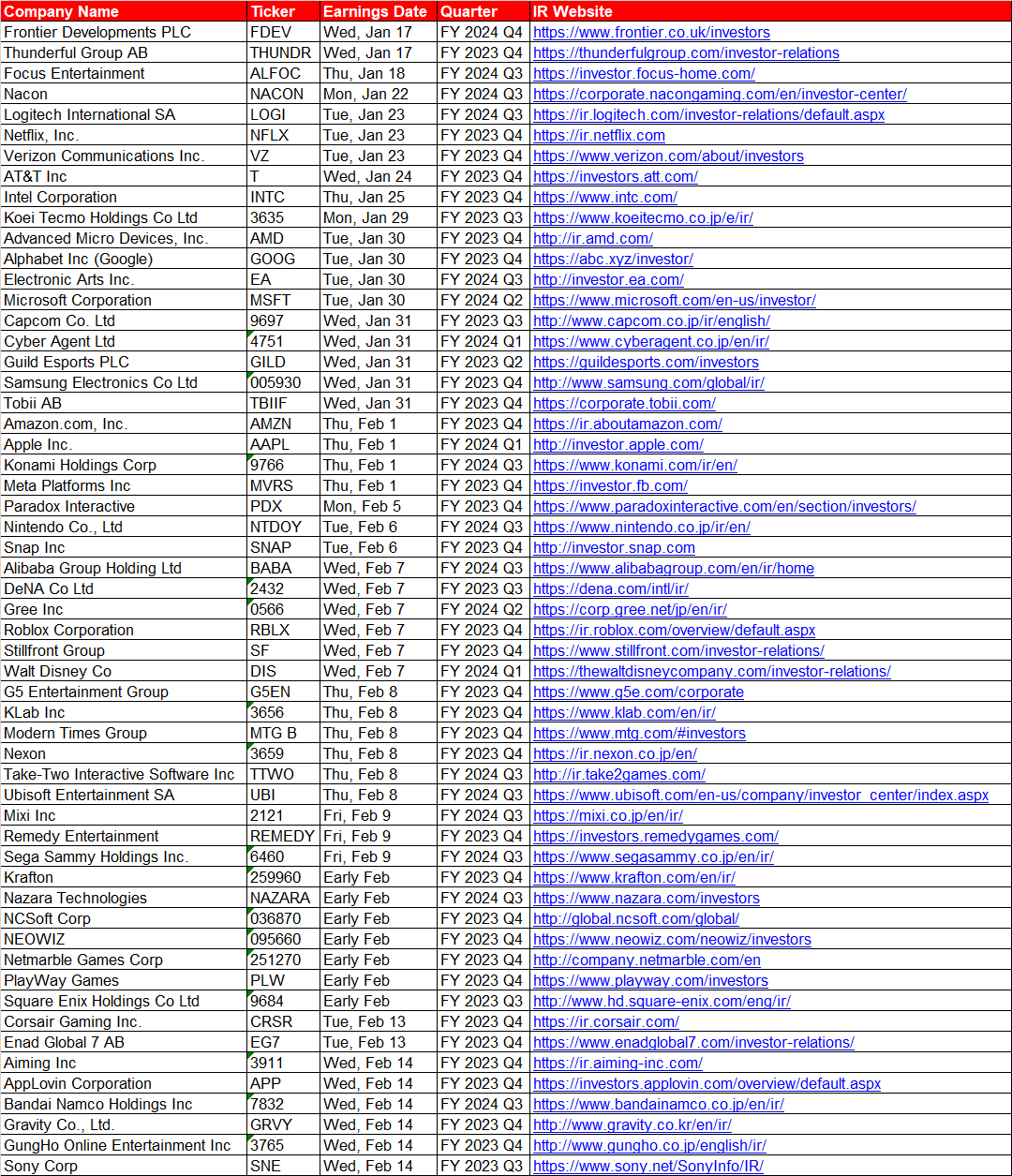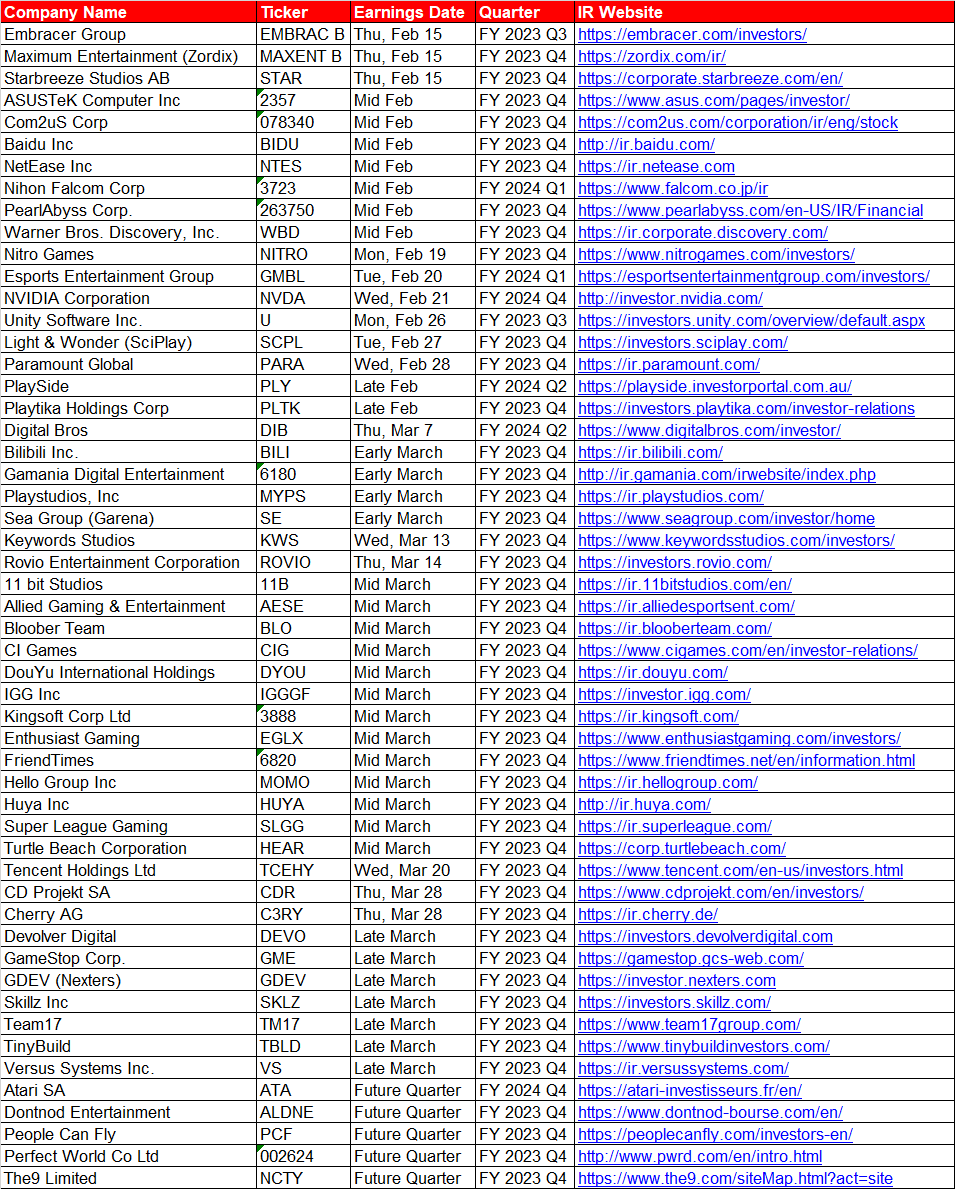- Thread starter
- #1
Hi, I'm ggx2ac.
I've been making financial results threads on forums for several years and as I kept making more threads I looked for more ways to improve on the threads I make.
We are currently going through the earnings results period for a lot of gaming companies during October to November (or pretty much almost every company in general) and the thread titles for some financial results threads have caught my attention.
I felt that since we are in a focused gaming sales forum, in my opinion it should have more specialist knowledge applied in relation to game sales and financial results.
This advice is intended for the novice and you are free to choose not to follow it. I just think that if you want to attract more visitors to this forum including that of professionals then conveying the information contained within your threads particularly in relation to financial results just requires understanding some terminology.
...And hey, maybe in the future someone will find this forum so valuable that they'll buy it for $1B.
This advice mainly pertains to financial results threads aka earnings results threads.
Whenever I make an earnings results thread, you would see something like "Q2 FY3/2021" written out by me.
Q2 refers to the second quarter, there are four quarters in a given year but each quarter does not correspond to the same three months it covers across companies. For example, Microsoft's first quarter covers July to September while Sony's first quarter covers April to June. Why is that so? This is to do with companies using a calendar that follows a fiscal year aka financial year. They do this for tax/accounting purposes. Companies who are headquartered in the same country may not be following the same fiscal year. For example, Nvidia, EA and Microsoft are all headquartered in the US. Nvidia's current fiscal year ends January 2022 (written as FY1/2022), EA's current fiscal year ends March 2022 (written as FY3/2022) and Microsoft's current fiscal year ends June 2022 (written as FY6/2022). Why do their fiscal years end at different months? I don't know.
"FY3/2021" in the example mentioned earlier is read as Fiscal year ending March 2021, you can also replace the word fiscal with financial and it's the same thing. The fiscal year can be written as FY3/21 to shorten it. Also, if you've read a Japanese company's earnings release and you notice them use FY21/3 or FY2021/3, it is the same thing as reading FY3/21, their date format starts with the year then month and then day. You need to be aware of how dates are formatted in various countries. There are other ways you can write a fiscal year date but I've forgotten, choose however you like but please make sure it's the correct terminology that is actually used and not something you made up. For example regarding things being made up, I've seen posts where someone wanted to track something by fiscal year for X company and they use FY1, FY2, FY3… etc which they designated as fiscal years to correspond to specific calendar years such as 2018, 2019, 2020.. etc. Just use the fiscal date that the company uses, you are creating unnecessary confusion by making up a new date system that is not going to see mass adoption unless you can somehow make a meme of it.
It is recommended that you write not just the fiscal year but also the month the fiscal year ends in. I've heard it before, you went to the Sony or Nintendo IR page to look at earnings releases and they had it grouped by financial year written as FY20 or FY2020 for example. Without the month given you do not know the 12 month period it is covering. You might not even be aware that one of those companies is listing FY2020 for when the fiscal year starts i.e. Starts April 2020 and ends March 2021 and the other company listing FY2020 is referring to the end of the previous fiscal year i.e. Starts April 2019 and ends March 2020. This is true, go search through IR pages of the different gaming companies and you will spot this.
Why should a fiscal year date be used in financial results threads? If I kept making Nintendo earnings results threads where the title only said Q1, Q2, Q3 or Q4, I would not be able to keep track of which fiscal year it is from and hence makes it difficult to search past threads. Also, if you chose to use the calendar year in your title that can also cause confusion because the 12 month period of the calendar year may not match the fiscal year of the company you made a thread about. In case you're wondering, there is a gaming company that has its fiscal year end in December e.g FY12/2022.
If you don't want to use fiscal year dates in your thread titles for financial results threads then that's your choice. Just please make sure you understand what you're posting, for example, someone made a financial results thread for Square Enix one time and I had to explain how they were incorrect about their interpretation of the fiscal year date being used by Square Enix. He interpreted FY2020/3 as being Fiscal year 2020, 3rd Quarter. That was completely wrong, do not make this mistake. He posted a graph from Square Enix which showed net sales and operating income by fiscal year. Each bar on the graph was labelled with a fiscal year such as FY2018/3 and he mistakenly interpreted this as data covering only the third quarter of each fiscal year, it did not. I had to show him using data from FY2018/3 using the fourth quarter earnings release of that year that the net sales and operating income was for the whole fiscal year and not just the third quarter. Here's the graph that I mentioned:

Regarding other words to use in the title of financial results threads, you can title it as financial results, earnings release, earnings results or even earnings announcement. As long as the terminology is correct.
I will update this thread later on with a bit of a glossary for what some terms mean that you might see in earnings releases or other statements such as press releases from companies.
This advice was only for one small portion of financial results threads. You can do anything you want in your financial results thread to improve whatever it is you are trying to convey. For example, I use programming to be able to post the data quicker than having to type everything manually, plus I am able to use it to show quarterly figures easily if the financial results provided by the company only show cumulative figures for the fiscal year.
You can choose to use images, such as making graphs but please, I don't want to make another thread having to explain how to make a graph because if there's one thing I must explain now, it's that you need to make sure that when you present data, that it can actually be read by a general audience. When you are trying to convey information to the audience, it helps to be concise. For example, one common thing I see regarding bad bar graphs happens when they're using it to show a comparison. There's nothing wrong with a few bars in a graph to show for example a bunch of games with their sales figures over time, the problem is when you decide to put 100 bars into the graph representing 100 different games to show sales figures over time. This doesn't help visualise things, it becomes very awful to look at and difficult to understand with what you are trying to convey, if you want to present that much data then you are better off just putting it into a table and not a graph.
In conclusion, it becomes a lot of work to improve with making financial results threads and, if you make really good financial results threads. Someone may end up plagiarizing your work which they could be making money off of.
Edit:
I have finally got around to adding some more advice, go to the following links below which will take you to the relevant post in this thread.
- How to read waterfall graphs
- Translating some shorthand words: ROE, ROIC, D/E, DOE
- Accounting Wars: GAAP vs IFRS
I've been making financial results threads on forums for several years and as I kept making more threads I looked for more ways to improve on the threads I make.
We are currently going through the earnings results period for a lot of gaming companies during October to November (or pretty much almost every company in general) and the thread titles for some financial results threads have caught my attention.
I felt that since we are in a focused gaming sales forum, in my opinion it should have more specialist knowledge applied in relation to game sales and financial results.
This advice is intended for the novice and you are free to choose not to follow it. I just think that if you want to attract more visitors to this forum including that of professionals then conveying the information contained within your threads particularly in relation to financial results just requires understanding some terminology.
...And hey, maybe in the future someone will find this forum so valuable that they'll buy it for $1B.
This advice mainly pertains to financial results threads aka earnings results threads.
Whenever I make an earnings results thread, you would see something like "Q2 FY3/2021" written out by me.
Q2 refers to the second quarter, there are four quarters in a given year but each quarter does not correspond to the same three months it covers across companies. For example, Microsoft's first quarter covers July to September while Sony's first quarter covers April to June. Why is that so? This is to do with companies using a calendar that follows a fiscal year aka financial year. They do this for tax/accounting purposes. Companies who are headquartered in the same country may not be following the same fiscal year. For example, Nvidia, EA and Microsoft are all headquartered in the US. Nvidia's current fiscal year ends January 2022 (written as FY1/2022), EA's current fiscal year ends March 2022 (written as FY3/2022) and Microsoft's current fiscal year ends June 2022 (written as FY6/2022). Why do their fiscal years end at different months? I don't know.
"FY3/2021" in the example mentioned earlier is read as Fiscal year ending March 2021, you can also replace the word fiscal with financial and it's the same thing. The fiscal year can be written as FY3/21 to shorten it. Also, if you've read a Japanese company's earnings release and you notice them use FY21/3 or FY2021/3, it is the same thing as reading FY3/21, their date format starts with the year then month and then day. You need to be aware of how dates are formatted in various countries. There are other ways you can write a fiscal year date but I've forgotten, choose however you like but please make sure it's the correct terminology that is actually used and not something you made up. For example regarding things being made up, I've seen posts where someone wanted to track something by fiscal year for X company and they use FY1, FY2, FY3… etc which they designated as fiscal years to correspond to specific calendar years such as 2018, 2019, 2020.. etc. Just use the fiscal date that the company uses, you are creating unnecessary confusion by making up a new date system that is not going to see mass adoption unless you can somehow make a meme of it.
It is recommended that you write not just the fiscal year but also the month the fiscal year ends in. I've heard it before, you went to the Sony or Nintendo IR page to look at earnings releases and they had it grouped by financial year written as FY20 or FY2020 for example. Without the month given you do not know the 12 month period it is covering. You might not even be aware that one of those companies is listing FY2020 for when the fiscal year starts i.e. Starts April 2020 and ends March 2021 and the other company listing FY2020 is referring to the end of the previous fiscal year i.e. Starts April 2019 and ends March 2020. This is true, go search through IR pages of the different gaming companies and you will spot this.
Why should a fiscal year date be used in financial results threads? If I kept making Nintendo earnings results threads where the title only said Q1, Q2, Q3 or Q4, I would not be able to keep track of which fiscal year it is from and hence makes it difficult to search past threads. Also, if you chose to use the calendar year in your title that can also cause confusion because the 12 month period of the calendar year may not match the fiscal year of the company you made a thread about. In case you're wondering, there is a gaming company that has its fiscal year end in December e.g FY12/2022.
If you don't want to use fiscal year dates in your thread titles for financial results threads then that's your choice. Just please make sure you understand what you're posting, for example, someone made a financial results thread for Square Enix one time and I had to explain how they were incorrect about their interpretation of the fiscal year date being used by Square Enix. He interpreted FY2020/3 as being Fiscal year 2020, 3rd Quarter. That was completely wrong, do not make this mistake. He posted a graph from Square Enix which showed net sales and operating income by fiscal year. Each bar on the graph was labelled with a fiscal year such as FY2018/3 and he mistakenly interpreted this as data covering only the third quarter of each fiscal year, it did not. I had to show him using data from FY2018/3 using the fourth quarter earnings release of that year that the net sales and operating income was for the whole fiscal year and not just the third quarter. Here's the graph that I mentioned:

Regarding other words to use in the title of financial results threads, you can title it as financial results, earnings release, earnings results or even earnings announcement. As long as the terminology is correct.
I will update this thread later on with a bit of a glossary for what some terms mean that you might see in earnings releases or other statements such as press releases from companies.
This advice was only for one small portion of financial results threads. You can do anything you want in your financial results thread to improve whatever it is you are trying to convey. For example, I use programming to be able to post the data quicker than having to type everything manually, plus I am able to use it to show quarterly figures easily if the financial results provided by the company only show cumulative figures for the fiscal year.
You can choose to use images, such as making graphs but please, I don't want to make another thread having to explain how to make a graph because if there's one thing I must explain now, it's that you need to make sure that when you present data, that it can actually be read by a general audience. When you are trying to convey information to the audience, it helps to be concise. For example, one common thing I see regarding bad bar graphs happens when they're using it to show a comparison. There's nothing wrong with a few bars in a graph to show for example a bunch of games with their sales figures over time, the problem is when you decide to put 100 bars into the graph representing 100 different games to show sales figures over time. This doesn't help visualise things, it becomes very awful to look at and difficult to understand with what you are trying to convey, if you want to present that much data then you are better off just putting it into a table and not a graph.
In conclusion, it becomes a lot of work to improve with making financial results threads and, if you make really good financial results threads. Someone may end up plagiarizing your work which they could be making money off of.
Edit:
I have finally got around to adding some more advice, go to the following links below which will take you to the relevant post in this thread.
- How to read waterfall graphs
- Translating some shorthand words: ROE, ROIC, D/E, DOE
- Accounting Wars: GAAP vs IFRS
Last edited:






